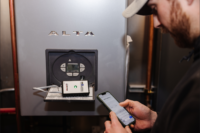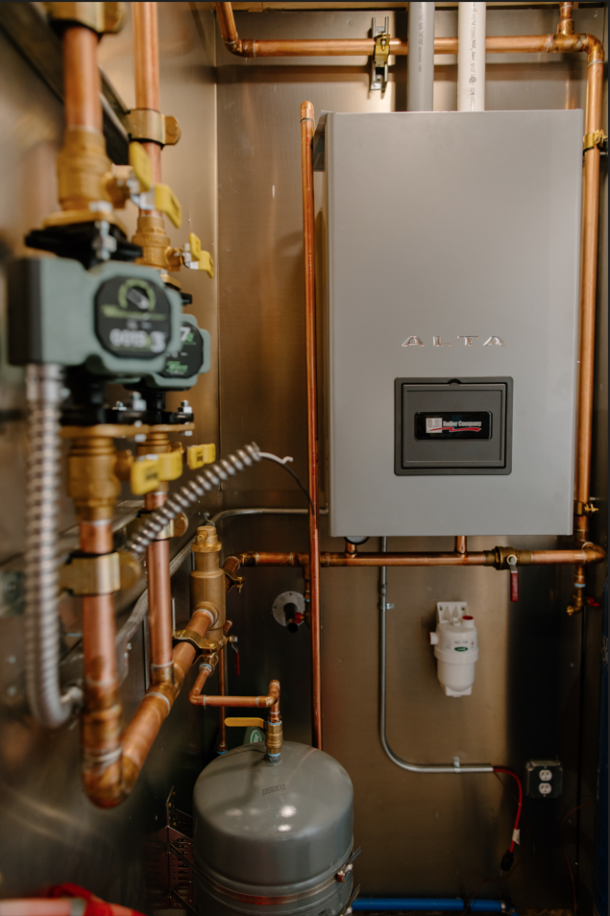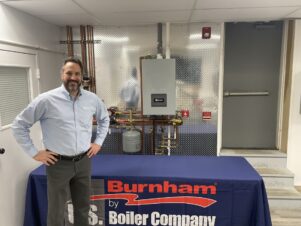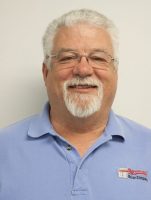Anyone with a military background will recall the U.S. Government’s penchant for acronyms. MREs, BDUs, MRAPs, the list goes on. Unfortunately, this dynamic is also present when discussing the efficiency enhancing feature known as outdoor reset. ODT, SWT, LWT, etc. It’s enough to cause a BM in your BVDs! Well, U.S. Boiler Company has once Read more
Outdoor Reset

Anyone with a military background will recall the U.S. Government’s penchant for acronyms. MREs, BDUs, MRAPs, the list goes on. Unfortunately, this dynamic is also present when discussing the efficiency enhancing feature known as outdoor reset. ODT, SWT, LWT, etc. It’s enough to cause a BM in your BVDs! Well, U.S. Boiler Company has once again developed a solution to make all this NBD.
First a few simple facts.
1. Flue gas will condense when temps are at or around 130° or less.
2. When vapor contained in flue gas condenses it releases a significant amount of heat.
3. Without question, optimal efficiency is achieved by heating a home using the lowest possible water temperature that will maintain the desired indoor target temperature, usually the thermostat set-point.
4. Using a Mod-Con, or high efficiency, gas boiler like the ALTA can take full advantage of the condensing action allowed by low water/flue temps.

Outdoor reset sensors do a wonderful thing. They enhance efficiency by matching water temperature to varying conditions. For example, one would want to maintain indoor design temp, normally 70°, during outdoor design temps (in CT normally 7-10 degrees.) Assume a 7° ODDT, and required SWT of 180. This means the boiler must deliver 180° supply water consistently at a 7° outdoor design temperature to maintain the desired indoor temp (IDT). This all simply means we need the hottest water when it’s coldest outside. Good so far?
As Paul Harvey used to say, “And now-The rest of the Story!” We now all understand (hopefully) what happens in our heating systems on the coldest day of the year. What about the rest of the time? Sure, that 180° water will heat the house just fine on a 50 degree day. But what about all the energy used to unnecessarily heat the water way past what would be required to keep the home comfortable? This is a net negative on many fronts, but most significant is the increased wear and tear on the heating unit.
So, your now asking “Tom, how low can my water temp be?” The answer will likely surprise you. Standard fin tube radiation works ok down to 130° water temps in most applications. Same with cast iron radiators. For the fin tube baseboard system in my house the minimum boiler water temp on my ALTAC-136 is 125 degrees. Hydro-air (hydronic coils added to or contained within hot air furnaces or air handlers) can often be run around 130° as well, depending on the occupant’s expectations. Remember, these SWT’s are typically targeted when the ODT is ~70°. We don’t need to transfer much heat to maintain indoor setpoints at these conditions. How does all this magic happen? Outdoor reset. Using a thermistor mounted outside, typically out of the sun on the north facing wall we monitor ODT and adjust SWT temp accordingly. So my personal curve used to be 180° SWT @ 7° ODT, and 125°SWT@70° ODT, but no more. My ALTA figures this out automatically without an outdoor reset sensor.
While outdoor reset simply monitors outdoor temperatures, rate-based reset works by looking at boiler run time, firing rate, and other parameters and adjusting accordingly. Here’s a few examples. Say it’s a beautiful spring day. Nice and sunny with a gentle breeze and 50° outdoor temperatures. The boiler run times are likely short, and the firing rate is likely low. The boiler knows from these conditions the heat loss from the house is minimal, and adjusts, incrementally dropping the boiler water temp until the minimum setpoint is reached, or our algorithm (the “secret sauce”) calculates that based on run time and firing rate the water temp will deliver enough heat to match the rate of heat loss and maintain indoor temp setpoints at the lowest possible SWT. As night rolls in and the temperature drops, average run times and firing rates increase, and once again, rate-based reset will adjust (increase) SWT’s to maintain indoor comfort and optimal efficiency. “Brilliant!” you say. I agree. But wait-there’s more!
Conventional ODR has limitations. Say the calculated water temp for a 45 degree day is 142°. It’s a moderately windy day. Consider two different houses, both 2,500 ft. The first has a well-sealed envelope, double pane windows, and effective insulation. The second has old single pane windows, minimal (or no) insulation, and is as drafty as old fence. The boiler doesn’t know what the indoor conditions are, just that it must target 142 degrees. That 142° SWT might be fine for the first, but far too low for the second. Now to be fair, all U.S. Boiler products with outdoor reset offer a “boost” feature that will automatically bump the temperature up every “X” (boost time value) minutes, default being 20. This means every 20 minutes with an uninterrupted call, the SWT will rise 10 degrees until the max setpoint is reached. The benefit of rate-based reset is we are always looking at indoor conditions and adjusting accordingly. Rate-based reset always uses the lowest possible water temp that will maintain the desired indoor temp, and then has the boost feature if an increase above the calculated target temp is required. Like a samurai sword: simple, elegant, and effective!
There are other benefits as well. Remember the test I mentioned? Here it is. What factors showcase the benefits of rate-based reset? See the answers below. Correct your test answers accordingly…
1. No sensor to install. Rate-based wins!
A) No sensor for landscape professionals to damage.
B) No sensor for contractor to install (or throw away!)
C) No wire required from boiler to sensor.
D) No worries about where the contractor will mount the sensor, if it will be impacted by the sun, or heat migration from the interior affecting the sensor calibration.
E) Enabled from the factory. No worries for homeowner regarding whether the contractor enabled ODR. The Alta boiler is set up for maximum comfort and efficiency right out of the box!

2. No Lemon Faces! Rate-based wins!
A) Always monitoring indoor temp. Onboard algorithms are constantly at work to meet heating demands while maintaining maximum efficiency. Tens of thousands of units installed with zero complaints about indoor temperature. When not writing informative and engaging articles such as this, I am a member of the renowned U.S. Boiler tech support team. I’ve honestly never received one complaint regarding rate-based reset. If you have, please contact me.
B) Not reliant on a technician with advanced, comprehensive knowledge of ODR curves. Works fine out of the box with no programming in most applications, and, where required, only minimal adjustments for almost all applications, including low temp radiant.
C) If the homeowner is made aware that during mild temperatures the radiators will not be the same temperature as the skin of the space shuttle during re-entry, and that these cooler temperatures mean more money in their pocket for candy/wine/shuffleboard, they will instead have smiles every time they touch the radiator. Or better yet, they will abandon the practice entirely…
3. Takes full advantage of condensing aspect of mod con boilers. Again, rate-based wins!
Regardless of ODT, rate-based reset always targets the lowest possible temp, thereby maximizing the potential for the boiler to run cool enough to operate in a range where flue gas condensation occurs.
I can almost feel grizzled old contractors firing up HP 386’s and waiting for the comforting squawk of their dial up modems connecting. I imagine most of the responses will begin with:
“Dear factory stooge/shill. Your article may fool the unwashed masses, but not me. My mom’s uncle’s grandmother has a hunting cabin with 1 radiator and 600 feet of ¾” pipe to connect the boiler to the house (it’s in the barn where we milk the squirrels). How does your new-fangled boiler work in my application? Hah!!! Gotcha!!!”
It will be this, or something substantially similar. There’s always at least one. For the rest of the world (and fortunately, most of the squirrels) these anomalies are rare. There is no magic solution for a poorly designed or installed system. But when a competent, capable, and progressive contractor is installing a new or replacement system, the advantage of rate-based reset over conventional sensor-based reset is clear. Reduced (or no!) programming required, no wires to pull, and no exposed exterior sensor susceptible to damage. Save time, money and aggravation. Go ahead and skip a step with ALTA.
For more information on the Alta boiler, visit our Alta Product Page.
 GUEST BLOGGER: Tom Secondino is a Technical Sales Support Specialist for U.S. Boiler Company, a manufacturer of residential and commercial heating products, including condensing, non-condensing and electric boilers.
GUEST BLOGGER: Tom Secondino is a Technical Sales Support Specialist for U.S. Boiler Company, a manufacturer of residential and commercial heating products, including condensing, non-condensing and electric boilers.
Watts will host a customer webinar, Snow Melting Solutions, on Thursday, August 27, at 11:00 am ET. This is the next installment in the Watts® Works℠ Engineer Webinar Series geared specifically towards engineers, architects, designers, specifiers, and facility managers. Snow melting systems are a convenient, cost effective way to clear snow and ice from outdoor Read more
Watts will host a customer webinar, Snow Melting Solutions, on Thursday, August 27, at 11:00 am ET. This is the next installment in the Watts® Works℠ Engineer Webinar Series geared specifically towards engineers, architects, designers, specifiers, and facility managers.

Snow melting systems are a convenient, cost effective way to clear snow and ice from outdoor walking and driving paths this winter.
During this webinar, our industry subject matter expert will discuss:
- How snow melting systems enhance safety and protection for home and business owners
- The cost advantages of snow melting vs. mechanical removal
By attending the entire webinar, attendees can receive 0.1 Continuing Education Units (CEUs) through the American Society of Plumbing Engineers (ASPE).
To register for this webinar, visit: https://bit.ly/319ZtCi.

What??? I hear this often. How about “It gets too cold here for OD reset”. Or even “I love OD reset, but I don’t understand how to adjust it.” Maybe even “I always get complaints from my customers that “the radiation is not hot enough since the new boiler went in” and one more, “It Read more
 What??? I hear this often. How about “It gets too cold here for OD reset”. Or even “I love OD reset, but I don’t understand how to adjust it.” Maybe even “I always get complaints from my customers that “the radiation is not hot enough since the new boiler went in” and one more, “It doesn’t work with this type of system”.
What??? I hear this often. How about “It gets too cold here for OD reset”. Or even “I love OD reset, but I don’t understand how to adjust it.” Maybe even “I always get complaints from my customers that “the radiation is not hot enough since the new boiler went in” and one more, “It doesn’t work with this type of system”.
So, let me ask you what kind of hot water system you know of where outdoor reset will not work? I’ll answer this with one word…..None.
OD reset works with all types of hot water systems. But anyway, a quick review; what benefit does OD reset provide? It saves fuel and creates higher comfort levels in the building, not to mention reducing short cycles. It does so by changing the system’s supply water temperature depending on the current outdoor conditions. A few things come into play here: heat loss of the home (size and level of insulation), radiation (type and quantity), and of course, climate.
Those of you who’ve attended one of my seminars know that I’m a big proponent of reducing fuel bills by optimizing boiler and system efficiency. How do we do that? Proper boiler sizing and OD reset.
I believe that not using outdoor reset at every opportunity is doing a dis-service to your customers. US Boiler includes outdoor reset on our high efficiency modulation/condensing boilers, and we even offer it in a wireless version now. We even offer optional OD reset cards that simply plug into most of our cast iron boiler control systems. In fact, to achieve maximum efficiency of a condensing boiler, you must use OD reset. The lower the water temperature, the higher the boiler efficiency.
But, back to the misconception that there are applications where outdoor reset doesn’t work. Let’s touch on the different system types and utilizing OD reset. I’ll discuss four basic types of systems: radiant floors, cast iron radiation, copper fin-tube baseboard and hydro-air.
But before we get into it, let’s take a quick look at the default factory ODR settings on our boilers:
- Low OD air temperature – 0°F
- High OD air temperature – 70°F
- Low boiler temperature – 110°F
- High boiler temperature – 180°F
- Minimum water temperature – 130°F
Radiant floors are installed in numerous ways. There’s staple-up, where the tubing is fastened to the underside of the sub-floor with or without heat transfer plates. Sometimes tubing is installed above the subfloor, with a lightweight gypcrete pour overtop the tubing. Or it can be installed above the subfloor in grooves, with flooring installed on top of it without a gypcrete pour. And of course, tubing can be installed under a concrete slab.
To maintain setpoint temperature, all of these systems will require different temperatures. The more mass and insulation below the tubing, the lower the required water temperature. And, with outdoor reset, all of these applications will provide efficient boiler operation. We could easily see water temperatures as low as 80°F or as high as 160°F. You may have to change the low boiler temperature, minimum water temperature and possibly the high boiler temperature depending on the specific application.
The folks that say they don’t need ODR on a radiant system claim that the slab’s thermal mass is enough to flywheel the system through outdoor temperature swings, and that the slab doesn’t respond quickly enough to make a difference, even with fluctuating supply water temperatures. It’s true that a radiant system doesn’t respond as quickly as copper fin-tube, for example, and yes, the thermal mass of the slab will hold a more constant room temperature.
But those are both comfort considerations, and while they’re important, they completely overlook the fact that even with an in-slab system, if the water temperature is too high, the boiler will be short cycling and burning more fuel than needed.
Keep in mind, because radiant systems are lower temperature by nature, you might need to change the default ADR settings
Cast iron radiation, contrary to popular belief, is low-temperature heating, especially in modern homes. Sure back in the heyday of standing cast iron radiators, they might have needed 170 degree water. With single pane, wooden frame windows and zero insulation in the walls and ceilings, homes had HUGE heat loads. Now, insulate that same house and install new windows, and what do you have? Probably about half the heat load, at most. But the cast iron radiators haven’t shrunk, so you’ll be overheating the home or short-cycling the boiler. Probably both…. Unless of course there was a way to drop the water temperature…. Ahhhh. Yes. Outdoor reset control.
I’ve been asked many times about what water temperature a cast iron systems requires. My answer is always the same: “That depends”. There’s a lot of mass and high water volume, so, if it’s an insulated home, the temperature likely doesn’t need to be very high. Despite that, I’ve seen plenty of cast iron jobs where none of the boiler settings were changed from factory settings.
In most cast iron applications where home has some insulation, I usually like to see the low boiler temperature, minimum water temperature, and possibly the high boiler temperature reduced. Do the homework. Do a heat loss, calculate the water temperature required at design temperature with the amount of installed radiation. Once you have your design water temp, change the OD design temperature to 60°F on the heat loss and calculate the minimum water temperature. You may be really surprised. See the feature article this month for an Alpine installed in a cast iron radiation system. Cast iron radiators and stainless steel boilers work together beautifully, as long as outdoor rest is installed and properly adjusted.
Copper fin-tube baseboard, when connected to a high-efficiency boiler, means that OD reset is a must. Not only is copper baseboard a very responsive system, but the supply temperature needed will vary greatly depending on the ratio of baseboard to heat loss. Some systems can actually operate with supply temperatures under 180°F when it’s below 0°F outside.
I know of a baseboard job is Andover, Mass., with a high limit of 163°F. Despite the bitter cold spells we’ve seen in the past two years, the temperature has never needed to be raised. He’s running a minimum boiler temperature at 120°F instead of 130°F, and a low boiler water temperature of 100°F. Outdoor reset changes the supply temperature accordingly, and the home is always comfortable.
There are still folks out there who think condensing boilers should never be used with fin-tube baseboard, because these systems require high water temperatures. It’s true that fin-tube does require, on average, higher water temps than other systems. But it’s really only at design temperatures where a mod/con boiler wouldn’t condense. For the other 99% percent of the heating season, with an OD reset installed, the boiler will run at maximum efficiency. Fin-tube and condensing boilers go together like peas and carrots, but only with outdoor reset.
Hydro-air might just have the most misconceptions surrounding it. And that’s understandable, because bringing air movement into the equation does tend to make it a bit more difficult for wet-heads like us. But one thing is for certain, you can lower the supply water temperature to your coils when the outdoor temperature gets milder.
Don’t believe me? We’ve kept tabs on a few hydro-air jobs, and next month we’ll talk all about it.
Ron Beck is the outside Technical Advisor and manager of Training for U.S. Boiler Company, where he’s been since 1998. Ron’s 38 years of experience in the heating industry include climbing the ranks of a HVAC company, from apprentice to service manager. Ron writes contributes “Beck Tips” for the US Boiler Report. Beck Tips consist of a lot of helpful technical advice for installing hydronic systems (proper boiler sizing, piping, etc).
